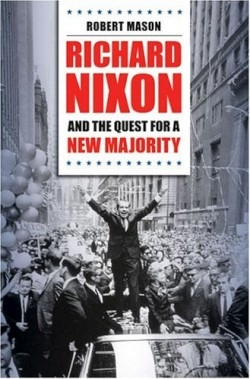Richard Nixon and the Quest for a New Majority
By the beginning of the 1970s, President Richard Nixon appeared poised to usher in a realignment of voters that would end the Democratic Party dominance that had existed since Franklin Roosevelt became president in 1932. In 1968, pundit James Reston identified a restive middle class “that resents racial turmoil, the demonstrations in the cities and all the permissiveness of American life.” These alienated voters, mostly lower- and middle-class Catholics, Irish, Poles, and white Southerners, became Richard Nixon’s “silent majority,” and his targeted groups to form the new conservative majority.
The author, a specialist in contemporary United States history and lecturer in history at the University of Edinburgh (UK) concludes in this authoritative and scholarly appraisal that Nixon failed at this quest and the Republican Party ascendancy would not occur until the 1980s and 1990s.
Nixon was elected president in 1968 with 43.4% of all votes cast, a smaller percentage than he received in 1960 when he lost to John F. Kennedy. This was hardly a mandate. Nixon’s New American Revolution of domestic reforms was further confounded by his lack of enthusiasm for working with the members of Congress who were needed to pass his proposed legislation. Ultimately, Nixon’s reforms failed, largely because programs like the Family Assistance Plan, which would provide a guaranteed income for welfare recipients, were too expensive to fund. In addition, Nixon was reluctant to promote his own NAR because it seemed more in tune with the Democratic Party than his Republican Party.
In the 1970 mid-term elections, Nixon failed to create a majority Conservative Party because he turned away from the bread-and-butter issues important to the electorate during those unsettled economic times. Instead he tried to garner public support by appealing to patriotism, which meant backing Nixon’s “peace with honor” strategy in Vietnam, and by faulting “radical liberal” programs that encouraged permissiveness and light sentences for criminals. Of the thirty-six Republican candidates whom Nixon stumped for, two-thirds lost. Congress remained controlled firmly by the Democrats.
Although the Nixon landslide of 1972 was a great personal victory for the President, it did not cause the realignment for which he hoped. The author claims that the Republican Party did not appeal to most voters and that Nixon was afraid of being dragged down with it. Nixon concluded, “we have lousy candidates: the good ones will go up with me, the bad ones will go down.” Nixon ultimately was the politician who fell because of his dirty tricks and abuse of Constitutional authority. Watergate ended Nixon’s quest for a new Conservative Party along with his presidency.
The author makes a strong case in this investigation-which will appeal greatly to political scholars-that Nixon received credit for a political realignment that he not only didn’t create but discouraged because his goal was his own election and not those of his fellow Republicans.
Reviewed by
Karl Helicher
Disclosure: This article is not an endorsement, but a review. The publisher of this book provided free copies of the book to have their book reviewed by a professional reviewer. No fee was paid by the publisher for this review. Foreword Reviews only recommends books that we love. Foreword Magazine, Inc. is disclosing this in accordance with the Federal Trade Commission’s 16 CFR, Part 255.

